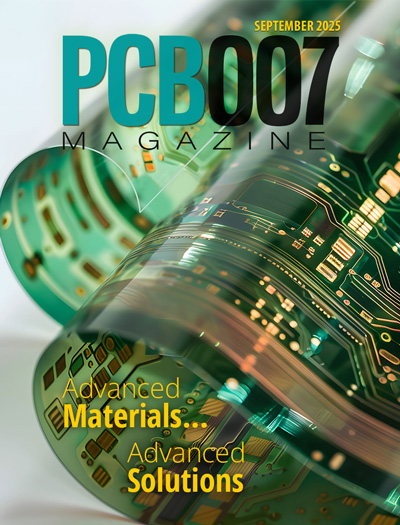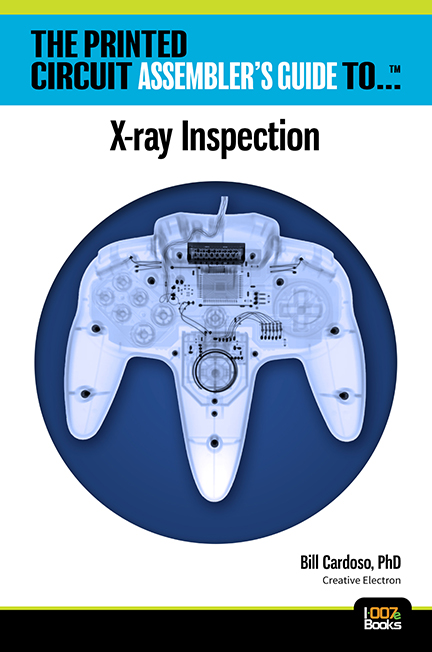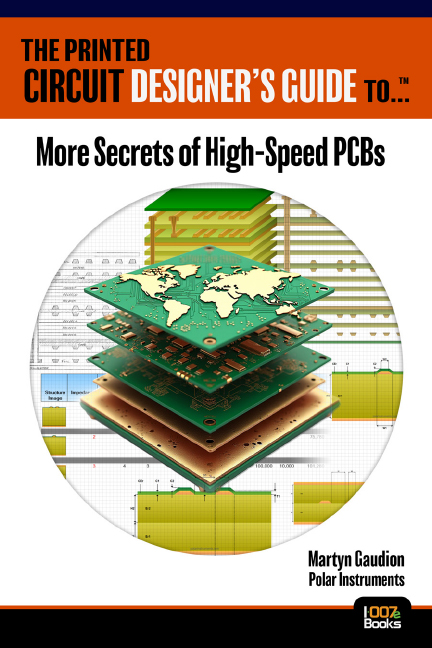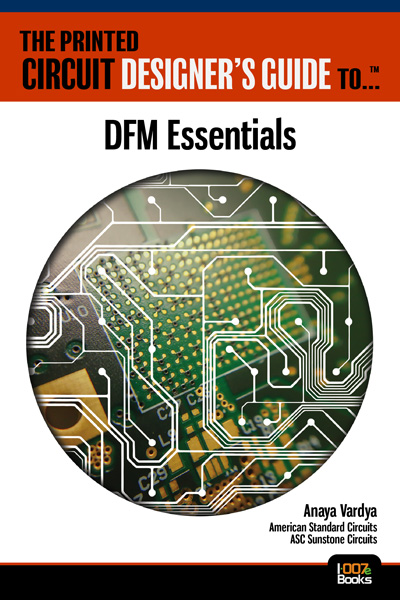-

- News
- Books
Featured Books
- pcb007 Magazine
Latest Issues
Current Issue
The Legislative Outlook: Helping or Hurting?
This month, we examine the rules and laws shaping the current global business landscape and how these factors may open some doors but may also complicate business operations, making profitability more challenging.

Advancing the Advanced Materials Discussion
Moore’s Law is no more, and the advanced material solutions to grapple with this reality are surprising, stunning, and perhaps a bit daunting. Buckle up for a dive into advanced materials and a glimpse into the next chapters of electronics manufacturing.

Inventing the Future With SEL
Two years after launching its state-of-the-art PCB facility, SEL shares lessons in vision, execution, and innovation, plus insights from industry icons and technology leaders shaping the future of PCB fabrication.
- Articles
- Columns
- Links
- Media kit
||| MENU - pcb007 Magazine
MKS’ Atotech and ESI to Participate at TPCA Show & IMPACT Conference 2024
October 23, 2024 | MKS Instruments, Inc.Estimated reading time: 4 minutes
MKS Instruments, Inc., a global provider of enabling technologies that transform our world, announced that its strategic brands ESI (laser systems) and Atotech (process chemicals, equipment, software, and services) will showcase their latest range of leading manufacturing solutions for printed circuit board (PCB) and package substrate manufacturing at the upcoming 25th Taiwan Circuit Board Industry International Exhibition 2024 to be held at the Taipei Nangang Exhibition Center from 23-25 October 2024.
Combining leading capabilities in lasers, optics, motion, process chemistry, and equipment, MKS is uniquely positioned to Optimize the InterconnectSM, a key enabler for the next generation of advanced electronics, which represents the next frontier in miniaturization and complexity. The Optimize the InterconnectSM approach demonstrates the company’s unique position to support the development of next-generation advanced PCB and package substrate manufacturing solutions for its customers and partners. “Our commitment to APAC is more than strategic, it is fundamental to our future. We are partnering with key manufacturers and supporting new technologies and ever smaller feature sizes by combining MKS’ ESI laser drilling technologies with MKS’ Atotech chemistry and plating equipment,” said Jim Schreiner, EVP and COO, MSD.”
The company has recently installed the latest equipment and process technology at its local APAC technology centers to drive the production of next generation package substrates and offer customers and OEMs faster development cycles for new products and materials, enabling high-end SAP technology requiring <=5/5µm lines and spaces.
Another example of progress comes from applications such as flex, advanced HDI or substrate-like PCBs. MKS can offer customers a comprehensive combination of optimized laser drilling, plating and surface modification chemistries and manufacturing equipment. Customers benefit from our unique one-stop-shop destination for pre-treatment, via formation, plating, and final finishing with fast turnaround times that don’t require production interruption, enabling our customers to achieve better yields, productivity, and performance. For substrate-like PCBs, MKS’ Atotech and ESI are currently working together with the industry to enable the next generation of mSAP technology and to introduce more sustainable solutions to comply with CO2 footprint reduction roadmaps, said Harald Ahnert, VP and GM Chemistry, MSD.
Wayne Cole, Senior VP, Global Sales and Service, adds, “As technology advances, semiconductors, package substrates and printed circuit boards continue to play a key role in driving innovation across multiple industries. These components are essential for powering next generation communication networks, enabling high-performance computing, supporting electrification in vehicles and advancements in driver assistance systems to pave the way towards sustainable transportation. These technologies are the foundation for a more connected and sustainable future. We are committed to meeting the evolving needs of our customers by delivering cutting-edge solutions that push the boundaries of electronics design. Experts from both brands will be available and ready to discuss latest industry trends and challenges at the TPCA Show booth K-915 on the 1st floor of the Nangang Exhibition Hall 1”.
On the chemistry side, highlights in surface treatment include EcoFlash® S300, a new differential etch solution suitable for advanced package substrates and , our new high-tech inner-layer adhesion promoter for high-speed AI applications. For metallization, our highlights include Printoganth® MV TP2, a high performance electroless copper process specifically designed for SAP fine line applications, and our even more enhanced Printoganth® MV TP3 process, which enables ultra-thin Cu deposition for fine lines down to 2/2 µm L/S, ideally combined with Cupraganth® MV, our new and revolutionary copper-based activation system. For electrolytic copper plating, we highlight our new reverse pulse plating solution for inclusion-free, high aspect ratio through hole filling of package substrate cores, Inpulse® 2THF2, and our production-proven InPro® SAP3 process for BMV filling with best surface distribution at high current densities. For conformal high hole density package substrate core plating we are promoting Cuprapulse® XP7-IN, our new solution for excellent plating uniformity.
For final finishing highlights range from the OSP solution OS-Tech® SIT 2, the new Aurotech® G-Bond 3 versatile gold bath for nickel/gold, nickel/palladium/gold and palladium/gold plating to Stannatech® for flex PCBs, as well as for thick tin plating of µ-LEDs or solder depot plating and Stannatech® IC for package substrates.
PCB equipment systems promotions include G-Plate®, a new HVM tool for PTH processes of next generation package substrates enabling highest yields and cutting-edge fine line capability targeting L/S <5/5 µm, vPlate®, a new vertical continuous plating tool for advanced HDI and package substrate for best-in-class surface uniformity. And last not least the new Uniplate®, the company’s flagship HVM system and industry-leading horizontal plating equipment for next-generation HDI PCBs and package substrate manufacturing.
Laser equipment promotions include the latest Capstone™, a high-performance/throughput breakthrough productivity for flex PCB UV drilling and Geode™ (CO2 and UV laser for HDI and package substrate applications). A special show highlight Geode™ A our new CO2 laser system for high precision and high-speed ABF build-up laminate processing. Geode™ G2 our new CO2 laser system for high-precision and high-speed HDI and mSAP via drilling. The Geode™ platform provides 15% higher optical transmission, 21% less total service area and up to 65% lower power consumption.
Testimonial
"In a year when every marketing dollar mattered, I chose to keep I-Connect007 in our 2025 plan. Their commitment to high-quality, insightful content aligns with Koh Young’s values and helps readers navigate a changing industry. "
Brent Fischthal - Koh YoungSuggested Items
Fresh PCB Concepts: Resilience and Renewal in Domestic PCB Manufacturing
10/30/2025 | Team NCAB -- Column: Fresh PCB ConceptsAs veterans of PCB manufacturing, we have spent much of our careers walking factory floors, examining copper circuits under microscopes, and troubleshooting plating lines when they go awry at 2 a.m. We can say with confidence that PCBs are the unsung heroes of modern life. They’re in everything, from toothbrushes and thermostats to satellites and defense systems.
MKS’ Atotech Showcases Next-gen PCB and Substrate Manufacturing Solutions at CPCA Plus 2025
10/24/2025 | MKS Inc.MKS Inc., a global provider of enabling technologies that transform our world, announced its participation in CPCA Plus Show 2025, taking place October 28 – 30 at Shenzhen International Convention and Exhibition Center.
MKS’ Atotech, ESI to Participate in TPCA Show & IMPACT Conference 2025
10/17/2025 | MKS’ AtotechMKS Inc., a global provider of enabling technologies that transform our world, announced that its strategic brands Atotech (process chemicals, equipment, software, and services) and ESI (laser systems) will showcase their latest range of leading manufacturing solutions for printed circuit board (PCB) and package substrate manufacturing at the upcoming 26th TPCA Show 2025 to be held at the Taipei Nangang Exhibition Center from 22-24 October 2025.
SCHMID Ships First InfinityLine P+ Panel-Level Plating System
10/08/2025 | SCHMID GroupSCHMID Group, a leading global provider of equipment and solutions for the electronics industry, announced the shipment of its first InfinityLine P+ system – a newly developed panel-level plating equipment with integrated photoresist stripping.
Transforming the Industry: Advint's Mission in Metallization
09/18/2025 | Marcy LaRont, PCB007 MagazineWith three decades of experience in engineering, research, and operations in blue-chip organizations, including Boeing and Honeywell, Venkat Raja has developed a passion for electroplating. In 2018, he founded Advint Incorporated, an electroplating advisory and training services firm dedicated to solving operational challenges, enhancing efficiency, and providing specialized training programs.


